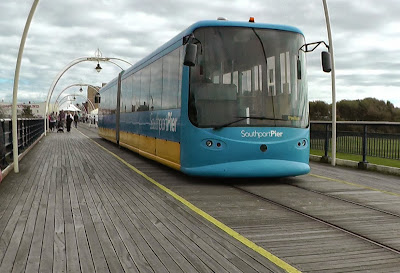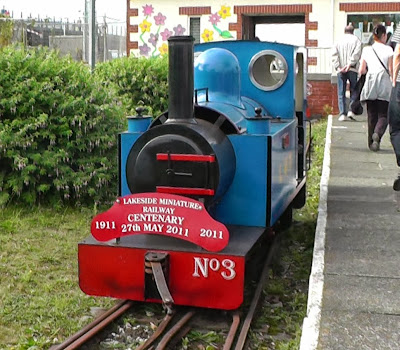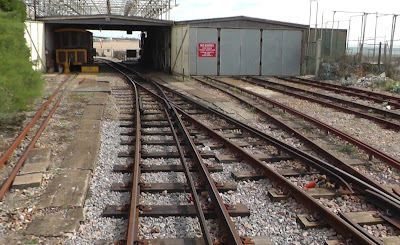In a nutshell
Gauge: 15"
Length: 1 mile (1.5km)
Opened: 1911
Location:
Lakeside Miniature Railway
Esplanade,
Southport,
Merseyside,
PR8
1RX
Date of visit: 22 September 2013
Key Facts
- The railway is the oldest continuously running miniature railway in the world (others closed during war years, eg Rhyl Miniature Railway which was built in the same year)
- The railway was opened on 25 May 1911 and ran alongside the Marine Lake with run-round loops at each end. It was extended in 1938 with a tight left-hand turn at the Northernmost end to a new terminus (Marine Parade Station) beside the pier.
- When first opened, the railway was operated by two Bassett-Lowke 4-4-2 steam locomotives, King George and Princess Elizabeth. These locomotives are still in existence, in America.
- The original locos were joined in 1919 by one of Sir Arthur Heywood's locomotives, Katie which had previously run on the Eaton Hall Railway and the Ravenglass & Eskdale Railway (see A chronology of Minimum Gauge railways). Katie was sold to the Fairbourne Railway in 1923.
- In 1948 a steam outline 4-6-2 petrol-electric tender locomotive (The Duke of Edinburgh), based on Gresley’s streamline A4 Pacifics, joined the railway. It was built by Harry Barlow who became the owner of the railway in 1945.
- Harry Barlow also built the locomotives for the Far Tottering and Oyster Creek Railway, based on the cartoons of Roland Emett, which appeared at the 1951 Festival of Britain.
- Two further petrol locomotives of a similar design were added in 1954 (Prince Charles) and 1963 (Golden Jubilee).
- A further loco, Princess Anne, a diesel hydraulic co-co loco similar to a Western diesel and built by Severn Lamb, joined the railway in 1971.
- The railway was taken over by Don Clark in 2001.
- Another loco, a 2-6-2 steam outline diesel hydraulic called Jenny, was added to the fleet in 2006. This loco was built for the LMR by Austin Moss at nearby Windmill Farm.
Route
My Impressions
After solving the first problem of finding somewhere to park (see below), my first objective was to get the lay of the land at Marine Parade Station. The station is located between Marine Parade and the pier.
Walking around the station, it's possible to take some pictures of the station from the first overbridge, which leads to a skateboard and BMX bike park. A little further along Marine Parade, it's possible to gain access to the pier .......
..... from which other views of the station can be gained.
As can be seen, the layout at the station provides for two platforms with separate run round loops on each.
Heading back to the station, I took a snap of the impressive station building which dates back to the days when the line was extended to its present position in 1938. After chatting with the owner's wife, Jenny, I made my way on to the platform to await the arrival of the next train.
Only one platform was in use - in fact the track to the other was quite overgrown, suggesting it had not been used for some time. A rake of two articulated open coaches was parked beside the main platform to be available should traffic demand their use.
At the other end of the platform, the line could be seen stretching out through a cutting towards the 90 degree right-hand bend which takes the railway alongside the lake. The overbridge to the skateboard park was clearly made from cast iron plates which bear the initials of the railway (LMRly).
Before long, there was the sound of a horn in the distance and the train came into view, the loco propelling the train of two articulated open coaches into the station.
The loco on duty for the day was
Jenny, a 2-6-2 steam outline diesel hydraulic loco which was constructed in 2006.
Talking with the driver, it seems that this loco is used when traffic is likely to be fairly light. The older, larger locos are pressed into service on a rolling basis during the season, dependent on anticipated traffic.
We clambered aboard and paid the modest fare (£1.50 single for me) .......
and within a short period we departed.
After passing beneath the bridge to the skateboard park .......
...... we rounded the curve to pass under the bridge giving access to the park, and then under the pier.
We then ran on a fairly straight route between the park and the lake. Looking back towards the pier, the lake can be seen on the right.
We passed beneath another bridge (under repair) ...........
....... before passing the stock sheds.
We then pulled into Pleasureland Station where there is an island platform with two
faces.
In addition to the two run round loops there is a carriage siding leading to another stock shed.
As with Marine Parade Station, it's clear that only one platform is in regular use, which presumably reflects the lack of demand for this type of seaside attraction these days.
I decided to walk the mile back to Marine Parade Station, to grab a few lineside shots. The entrance to the station announces as clearly as possible the presence of the railway.
As does the nameboard on the platform for those walking in the park beside the Marine Lake.
The walk along the path between the lake and the railway is quite pleasant, punctuated occasionally by the passing of a train. Here we see
Jenny passing over the points leading to the stock sheds .........
...... and here further along the line towards Marine Parade.
The track is quite well maintained though a covering of weeds gives it that Light Railway look .........
As the line begins it curve towards Marine Parade Station, the line towards Pleasureland Station can be seen almost in its entirety.
..... while the other end of the curve beside the skateboard park shows the width of the cutting.
As the afternoon wore on the number of passengers increased meaning that the second rake of coaches was pressed into service and the loco was required to run round its train at each end.
It was satisfying to see the railway attracting more passengers .......
..... though it is doubtful as to whether it will ever become as popular as it was in its early days, as evidenced by these pictures on display in the station building at Marine Parade . Clearly, the novelty of seeing a train in miniature was a great attraction.
It seems a great pity that many of the visitors strolling along the pier and catching a glimpse of the railway are probably blissfully unaware of its fascinating history and its contribution to the world of miniature railways. However, even at the end of the season, the railway was carrying a fair number of passengers. I overheard one passenger enquiring, "Where does it go?" and when told it went up to Pleasureland he replied, "Oh, that's all right then" suggesting that the length of the ride was about right for a day out at the seaside.
Practicalities
Parking
There are no parking facilities specific to the railway at either end but there are several public car parks. We discovered that we could park in the car park on the right hand side of Marine Parade opposite the station for two hours without charge (or longer if something was purchased in the shops.
Refreshments
Apart from selling sweets, ice cream and hot drinks at Marine Parade Station, the railway does not have a cafe. However, there are many and varied sources of refreshment within a short distance of the two stations.
Disabled Access
There are no steps to access the platforms at either station which are both approached by ramps. On the day I visited, there was no carriage which could accommodate wheelchairs available. There is a telephone number on the railway's website to which enquiries could be made.
Video
[In preparation]





































































